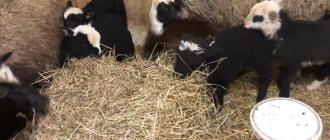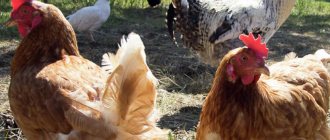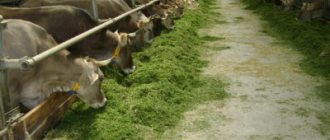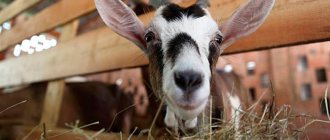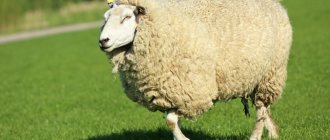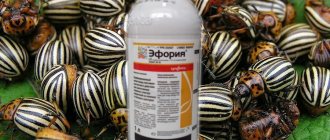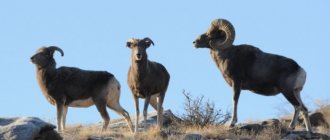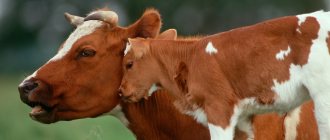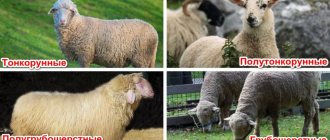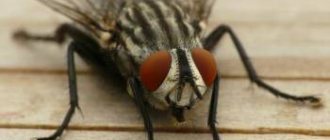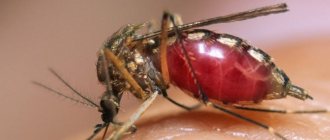Timing and organization of pasture use
How to use pasture rationally:
- analyze grass yields;
- calculate the timing of plants being eaten by animals;
- determine the permissible number of individuals per hectare of area.
The time of pasture use is limited by the maturation and restoration of grass cover. To prevent animals from trampling down the grass too quickly, the area is divided into squares and portable fences are installed. When the sheep eat the grass in one area, the partitions are moved to the next square and the animals are transferred there. The grass cover is restored within a month. Therefore, the flock is allowed into the first area no earlier than this time. The area of the plots is calculated so that the herd has enough food for a week.
Sheep feeding period
Production experience and scientific data show that sheep feeding should be carried out throughout the entire grazing period. From the beginning of spring to mid-summer, ewes of different ages are fed for feeding, and from the second half of summer - culled ewes, as well as ewes of the current year of birth, which, after fattening, must be sold for meat in November-December.
It is especially effective to feed and organize fattening of sheep in the spring and summer, when the main food is green grass. The dry matter of green food is rich in protein and minerals. Green food, due to its juiciness and tenderness, as well as the content of aromatic substances, is very well eaten by all animals. The organic substances contained in it are digested by sheep on average by 75-80%. Green food is a good source of vitamins, primarily provitamin A.
| On a note. During feeding, there is no need to incur costs for animal housing, cleaning and supply of feed. During 2 months of feeding, 2-year-old fine-fleece dams increase their weight by 8-9 kg, and culled queens during the same period of autumn feeding with additional feeding increase their weight by 7-8 kg. |
Grazing rules
Animals are gradually transferred from confinement to grazing on pasture.
Preparation
A sharp transition from winter keeping in a barn to grazing causes digestive upset in sheep. Therefore, the flock is prepared according to the following rules:
- released to graze for an hour in the afternoon;
- before grazing they are fed with hay;
- upon returning to the barn, they give plenty of water.
General preparation rules:
- conduct a veterinary examination of animals, vaccination against ticks, parasites and infections;
- trim the hair on the hooves and around the eyes;
- divide the herd into flocks based on age and wool quality.
The pasture is preliminarily inspected, places for rest and grazing are designated, and a movement schedule is drawn up.
Schedule
Sheep are released to pasture in late spring - in the middle or end of May, depending on the climate. At the beginning of the month, the grass is not yet tall enough and nutritious.
Grazing begins at dawn. Approximate schedule:
| Time | Action | Description |
| 05:00 | The flock is driven out to pasture | Early in the morning it is not hot and there are no blood-sucking insects. |
| 11:00-12:00 | Sheep are driven into the shade, to the river for an afternoon rest | The daytime crossing begins earlier on particularly hot days. If the weather is cool and cloudy, the herd is not moved or grazed until noon |
| 15:00 | The herd is taken out to pasture | The heat is subsiding |
| 20:00-21:00 | Otaru is taken home | In summer, the herd can stay in the meadow longer |
During spring grazing, sheep are turned out to the legume area after the morning dew has subsided and before the evening dew falls. Young moist stems ferment in the stomachs of animals, and as a result, the disease tympania develops.
Features of summer grazing:
- early arrival due to dew;
- moving to the shade to chew grass;
- night grazing.
Animals are brought to the field at 18:00. They feed until one in the morning, rest for two hours and feed again until ten or eleven in the morning. During the day, the herd rests in the sheepfold. In summer, dew softens grains and helps them digest better. But you should not graze your flock on wet alfalfa.
During winter grazing, the herd is released to pasture at 11 am. Covered parking lots with a supply of hay and water are equipped on the territory. In case of bad weather, animals are driven under shelters. Sheep farming uses grazing methods without a shepherd. Animals are kept in open pens with electric current running through the fences. Low voltage is safe for the ram, ewe and lamb, but will prevent the herd from scattering around the area.
See also
Tables of average live weight of lamb and carcasses of different breedsRead
Organization of a watering place
In summer, sheep find it more difficult to tolerate thirst than hunger. On hot days, animals are given water three times a day. In autumn, the number of trips to watering places is reduced to two times. On particularly cool days, sheep are given water once a day.
The maximum distance a herd can travel is 3 kilometers. If the reservoir is located further away, water is transported to the pasture. Sheep that travel long distances every day gain weight worse.
Types of pastures
It is always necessary to take into account the fact that the nutritional value of green forage in different seasons on pastures is not the same. The grazing requirements of different groups of animals also differ.
Pastures can be virgin, fallow, mountain, forest and swampy. Sheep also graze through the stubble, but only until the plowing snow rises.
Virgin pastures are used mainly in the spring, when the grass has not yet burned out, or in the fall, when it has turned green again due to precipitation. But fallow pastures are suitable for use in the summer, since they do not burn out as much. Mountain and foothill pastures can also be used in the summer, before the autumn rains.
As for forest pastures, they are least suitable for sheep. Swampy lands can be used only after drainage, however, on such lands it is necessary to strictly monitor the development of parasites and carry out preventive veterinary and animal health measures to combat helminthic diseases.
When distributing pastures, you need to carefully monitor the condition of their vegetation. In dry areas, it is best to primarily use fescue and bluegrass-wormwood pastures. In spring, the vegetation of these pastures is readily eaten by sheep.
Then you can graze the feather grass pastures, but this must be done before the feather grass seeds ripen. If sheep's wool becomes clogged with feather grass seeds, it will be impossible to completely clean it even under production conditions. In addition, the seeds sometimes pierce the skin of animals and, when entering the body of a sheep, cause illness and often death (this is especially true for fine-wool sheep). After feather grass grazing, use weedy, then wheatgrass and other pastures. Lastly, salt marsh grazing.
Tips and tricks
How to start herding sheep:
- during the first grazing, do not move frequently from one place to another, so as not to disturb;
- young animals and breeding stock are brought to the best lands;
- graze in a deployed formation so as not to trample the area;
- When choosing terrain, give preference to areas with a high content of white clover and timothy.
In summer, sites should be changed every 12 days to reduce the likelihood of infection with worms and parasitic blow flies;
Specific commands
In addition to the basic set of commands, dogs that herd sheep must learn special herding commands: “Chase”, “Around”, “Look”, “Guard”.
The “Drive” command is used by shepherds to drive their flock to pasture or drive it to a new place. At the training stage, the dogs are given this command at a distance of 10-12 meters from the lagging sheep. The dog should take off and chase the animal, directing it towards the main herd. As soon as the goal is achieved, the shepherd will give the command “Come to me.”
The “Circle” command is necessary to gather stragglers into a pile. At this command, the dog must run around the flock in a circle, driving away stray sheep. Training for this command begins on a leash, walking around a small obstacle in a circle. Gradually, as the command is mastered, the leash is loosened and then removed altogether.
Learning the “Look” command is necessary for finding lost animals. This command is extremely important for dog breeds herding sheep in the mountains or pastures with high vegetation. To teach dogs to search, several sheep are hidden in the bushes and given the command “Search.” As soon as the dog finds the sheep, the “Voice” command sounds. A dog trained in this way can find lost sheep in a matter of minutes and signal their location with a voice.
The “Security” command is issued when there is a threat of an attack on a herd of predatory animals. To practice it, the shepherd uses an assistant who simulates an ambush attack on sheep. The dog's task is to chase towards the attacker, driving him away from the herd.
Having learned these simple commands, the dog will be able to herd sheep without a shepherd.
The video shows how a dog herds and herds sheep:
What difficulties may arise
Before you start grazing you need to know that:
- spring grass contains a lot of potassium. Sheep suffer from convulsions from excess of the substance. Excess potassium is balanced with sodium, which is contained in salt. The daily norm for an adult animal in the spring is 10 grams;
- hatching on alfalfa is alternated with feeding on natural pasture. The stems of the plant are covered in the stomach with ordinary herbs and are better absorbed;
- Not all clover is good for sheep. A plant with red flowers in the first year of growth contains a nerve poison. Sheep are allowed into the red clover field after harvesting in the second year;
- The sheep huddle tightly together and keep each other warm. The herd instinct is useful in winter, but dangerous in summer. Animals must be separated to prevent heatstroke.
The health and fatness of the sheep depend on the skill of the shepherd. An experienced shepherd understands useful and harmful herbs and determines the duration of grazing based on the weather.
How to herd sheep correctly
Sheep must be grazed slowly, given that strong animals always run ahead and eat the best feed, while weaker sheep lag behind and receive worse feed, which makes them lose weight even more. Merino sheep, as less active animals, should be grazed separately from coarse-wool sheep, since the latter, running ahead, eat and trample the grass. In the summer, in hot weather, good shepherds graze sheep at night, and in the morning they drive the sheep into the wind so that during the day during the heat they return to the parking lot against the wind, if possible, so that the sun is behind and does not shine in the eyes of the sheep. During the day you can fish on the fishingby.com lakes, as they do in Belarus, and do grazing at night, cooking wonderful fish soup from freshly caught fish over the fire.
In the fall, in colder weather, the sheep are driven in the morning against the wind so that in the evening, when it gets cold, the sheep can be driven to the parking lot downwind. With such grazing, the sheep eat better.
When standing on the rear and during grazing, you need to sort out the sheep and carefully monitor each sheep. It is necessary to trim their hooves, fight worms (larvae of blowflies), and constantly ensure that scabies does not appear or spread on the animals. Counting the sheep of the entire flock should be done less frequently in order to avoid a decrease in the fatness of the livestock.
In order to make it easier to count sheep, kill young animals, separate the necessary animals from the herd, identify the sick, etc., the so-called “split” should be used, which is made from portable shields.
Sheep (no more than two in a row) are herded into a narrow run, no more than 0.75 meters wide. At the end of the “split” there is a shepherd counting sheep.
Sheep grazing rate per 1 ha
The rate of grass consumption depends on the type of pasture and the number of sheep.
To calculate how many animals should graze on one hectare of field, use the following formula:
G = U / N x P
Formula variables mean:
- G - number of sheep;
- Y is the yield per hectare multiplied by the percentage of pasture use;
- N is the amount of green mass that sheep eat during grazing;
- P is the period of use of pasture.
Natural lands are used by 60 percent, and artificial ones by 90. Grazing lasts 6 hours without taking into account the midday rest. One sheep eats 2 kilograms of greens per hour or 12 kilograms per day on grazing.
What to feed sheep
Of course, the best pastures should be reserved for this year's young animals. Also, along with pasture feeding, lambs should be fed with concentrated feed. Breeding rams should receive good pastures near the sheepfold and an additional supplement in the form of concentrates. To maintain good milk production, suckling queens need to be provided, if possible, with the most succulent fallow pastures with rich grass.
But yearling lambs and lambs, not intended for fattening, can graze on remote and poorer pastures.
Choosing a sheep breed
When choosing a breed, you should find out about the adaptability of a particular breed to certain climate conditions. The average lifespan of a sheep is fourteen years, but they are kept from six to eight years, after which they are used for meat.
When choosing sheep, you need to pay attention to the development of the animal's bones, since highly productive sheep are cattle with a good and strong body constitution.
Sheep breeds have the following classification:
- Fine wool sheep breeds
- Coarse-haired and semi-coarse-haired
- Meat and wool
- Meat-wool-dairy breeds
- Sheepskin coats
- Smushkov sheep
The most popular breeds for breeding in the CIS countries are Romanov sheep, Texel, Gissar sheep, Jaidar, Askanian sheep, Zvartbles, Ratzka, southern meat and so on.
What is sheep farming
Sheep farming is the breeding of sheep for profit in the form of production of certain products. The advantages of home sheep farming include the ease of raising sheep, which need fresh grass in the summer and shelter and hay in the cold season.
There is no need to build special pens for sheep, and they also do not need separate technical equipment. This is a very convenient and profitable type of cattle breeding, which is constantly developing.
- Today, there are more than six hundred breeds of sheep that were bred by breeders.
- Each of the breeds has a certain resistance to different climates, successfully taking root in mountainous or steppe areas.
- Sheep are very mobile and hardy animals, easily covering long distances.
The convenience of keeping and grazing them lies in the fact that the sheep consume natural food, so feeding a large herd does not require any special expenses.
Stall period
For the stall period, it is necessary to prepare at least 500 kilograms of good hay per head, 500-700 kilograms of succulent feed (potatoes, root vegetables, silage) and 100 kilograms of concentrates, including salt, chalk, bone meal.
In the sheepfold, everything should be repaired by winter, the walls should be sufficiently insulated, doors and frames should be adjusted so that there are no drafts. If it’s stuffy in the sheepfold in winter, then the glass is removed from the windows, and the opening can be covered with fabric, then the air will pass through and there will be no draft. By the beginning of the stall period, you need to install feeders and drinking bowls. The room should not be cramped to avoid injury and disease to the livestock.
In an insufficiently insulated and equipped barn, they may not tolerate the stall period well, because in central Russia it lasts up to 7 months. The air temperature in the sheepfold in winter should be no lower than 6-8 °C, and when the lambs appear, then up to 15 °C. Suspended sheep must be kept separately. The sheepfold must be dry, clean, it must be cleaned regularly and the bedding must be changed.
Feeding during the stall period
It is better to feed lambs outside, in a pen, or under a canopy in bad weather.
It's best to do it 3-4 times a day. If you feed them at a certain time, then between feedings they behave calmly and do not scream. At night, each tree is left with 1-2 brooms from branches with leaves harvested in the summer. You definitely need to water them a lot, as they feed on dry food.
It is better to distribute feed over time: give hay in the morning, in the afternoon - hay, brooms plus succulent feed, cut into pieces and sprinkled with bran, in the evening - concentrates and hay. Individuals destined for meat are fed hay, mainly legumes and cereals. Don't forget to give them salt.
